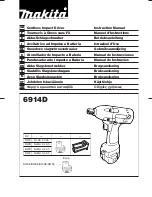
3
keys, nails, screws or other small metal objects,
that can make a connection from one terminal to
another.
Shorting the battery terminals together may
•
Under abusive conditions, liquid may be ejected
from the battery; avoid contact. If contact ac-
-
tacts eyes, additionally seek medical help.
Liquid
ejected from the battery may cause irritation or burns.
•
Do not use a battery pack or tool that is dam-
Damaged
may exhibit unpredictable behavior resulting in
explosion or risk of injury.
•
Do
excessive temperature.
-
perature above 130°C (265°F) may cause explosion.
•
Follow all charging instructions and do not
charge the battery pack or tool outside the
Charging improperly or at temperatures outside the
SERVICE
•
Ha
repair person using only identical replacement
parts.
This will ensure that the safety of the power
tool is maintained.
•
Never service damaged battery packs.
Service
of battery packs should only be performed by the
manufacturer or authorised service providers.
SPECIFIC SAFETY RULES FOR
IMPACT WRENCHES
•
Hold power tool by insulated gripping surfaces,
when performing an operation where the fastener
may contact hidden wiring.
Fasteners contacting
a “live” wire may make exposed metal parts of the
power tool “live” and could give the operator an electric
shock.
•
Wear ear protectors when impact drilling.
Expo-
sure to noise can cause hearing loss.
•
Use
-
cally designed for use on impact wrenches and
drivers.
Other sockets and accessories might shatter
or break causing injury.
•
•
WARNING
Some dust created by power sanding,
sawing, grinding, drilling, and other
construction activities contains chemicals known to
cause cancer, birth defects or other reproductive
harm. Some examples of these chemicals are:
•
lead from lead-based paint
•
crystalline silica from bricks and cement and other
masonry products, and
•
arsenic and chromium from chemically-treated lumber.
Your risk from these exposures varies, depending on
how often you do this type of work. To reduce your
exposure to these chemicals: work in a well ventilated
area, and work with approved safety equipment, such
as those dust masks that are specially designed to
SYMBOLOGY
Volts
Direct Current
No Load Revolutions per Minute (RPM)
Impacts per Minute Under Load (IPM)
SPECIFICATIONS
Volts .............................................................. 18 DC
Battery Type .................................................M18™
Charger
Type ................................................M18™
Recommended Ambient
Operating Temperature .....................-17°C to 51°C
Cat. No. ....................................M18 ONEFHIWP12
Anvil Type ...................................... 1/2" Square-Pin
RPM ............................................................. 0-1800
IPM .............................................................. 0-2400
Cat. No. ....................................M18 ONEFHIWF12
Anvil Type ....................................1/2" Square-Ring
RPM ............................................................. 0-1750
IPM .............................................................. 0-2100
Cat. No. ....................................M18 ONEFHIWF34
Anvil Type ....................................3/4" Square-Ring
RPM ............................................................. 0-1800
IPM .............................................................. 0-2400
FUNCTIONAL DESCRIPTION
1. 1/2" Square drive anvil with pin detent
(M18 ONEFHIWP12)
2. Control switch
3. Trigger
4. 4-Mode Drive Control
5. LED
6. Handle
7. 1/2" Square drive anvil with friction ring
(M18 ONEFHIWF12)
8. 3/4" Square drive anvil with friction ring
(
021()+,:)
)
1
2
4
5
3
7
6
8
ASSEMBLY
WARNING
Recharge only with the charger
-
manual supplied with your charger and battery.
Removing/Inserting the Battery
To
remove
the battery, push in the release buttons
and pull the battery pack away from the tool.
Maintain labels and nameplates.
These carry
important information. If unreadable or missing,
contact a
MILWAUKEE
®
service facility for a
replacement.
ADDITIONAL BATTERY SAFETY RULES
To reduce the risk of fire, personal
injury, and product damage due to a
WARNING
short circuit, never immerse your tool, battery pack or
charger in fluid or allow a fluid to flow inside them.
Corrosive or conductive fluids, such as seawater,
certain industrial chemicals, and bleach or
bleach-containing products, etc., can cause a short
circuit.
Regulatory Compliance Mark
(RCM). This product meets
applicable regulatory requirements.


























